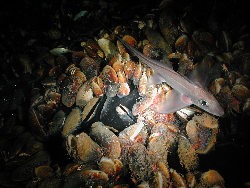
Brine pool
Encyclopedia


Brine
Brine is water, saturated or nearly saturated with salt .Brine is used to preserve vegetables, fruit, fish, and meat, in a process known as brining . Brine is also commonly used to age Halloumi and Feta cheeses, or for pickling foodstuffs, as a means of preserving them...
on the ocean basin. These pools are bodies of water that have a salinity
Salinity
Salinity is the saltiness or dissolved salt content of a body of water. It is a general term used to describe the levels of different salts such as sodium chloride, magnesium and calcium sulfates, and bicarbonates...
three to five times greater than the surrounding ocean. For deep-sea brine pools, the source of the salt is the dissolution of large salt
Sodium chloride
Sodium chloride, also known as salt, common salt, table salt or halite, is an inorganic compound with the formula NaCl. Sodium chloride is the salt most responsible for the salinity of the ocean and of the extracellular fluid of many multicellular organisms...
deposits through salt tectonics
Salt tectonics
500px|thumb|rightSalt tectonics is concerned with the geometries and processes associated with the presence of significant thicknesses of evaporites containing rock salt within a stratigraphic sequence of rocks...
. The brine often contains high concentrations of methane, providing energy
Energy
In physics, energy is an indirectly observed quantity. It is often understood as the ability a physical system has to do work on other physical systems...
to chemosynthetic
Chemosynthesis
In biochemistry, chemosynthesis is the biological conversion of one or more carbon molecules and nutrients into organic matter using the oxidation of inorganic molecules or methane as a source of energy, rather than sunlight, as in photosynthesis...
animals that live near the pool. These creatures are often extremophiles. Brine pools are also known to exist on the Antarctic Shelf
Antarctic continental shelf
The Antarctic continental shelf is a geological feature that underlies the Southern Ocean, surrounding the continent of Antarctica. The shelf is generally narrow and unusually deep, its edge lying at depths of 400 to 800 meters . It is home to a thriving ecosystem of penguins and cold-water fish....
where the source of brine is salt excluded during formation of sea ice. Deep-sea and Antarctic brine pools can be toxic to marine animals.
Characteristics
Brine pools are sometimes called seafloor "lakes" because the dense brine does not easily mix with overlying seawater. The high salinity raises the density of the brine, which creates a distinct surface and shoreline for the pool. When submarineSubmarine
A submarine is a watercraft capable of independent operation below the surface of the water. It differs from a submersible, which has more limited underwater capability...
s dive into brine pools, they float on the brine surface due to the high density. The motion of a submarine can create waves across the brine-seawater interface that wash over the surrounding "shoreline."
Support of life
Deep sea brine pools often coincide with cold seepCold seep
A cold seep is an area of the ocean floor where hydrogen sulfide, methane and other hydrocarbon-rich fluid seepage occurs, often in the form of a brine pool...
activity. Methane
Methane
Methane is a chemical compound with the chemical formula . It is the simplest alkane, the principal component of natural gas, and probably the most abundant organic compound on earth. The relative abundance of methane makes it an attractive fuel...
released by the seep is processed by bacteria
Bacteria
Bacteria are a large domain of prokaryotic microorganisms. Typically a few micrometres in length, bacteria have a wide range of shapes, ranging from spheres to rods and spirals...
, which have a symbiotic
Symbiosis
Symbiosis is close and often long-term interaction between different biological species. In 1877 Bennett used the word symbiosis to describe the mutualistic relationship in lichens...
relationship with seep mussels living at the edge of the pool. This ecosystem is dependent on chemical energy
Chemical energy
Chemical energy is the potential of a chemical substance to undergo a transformation through a chemical reaction or, to transform other chemical substances...
, and unlike almost all other life on Earth, has little dependence on energy from the sun
Sun
The Sun is the star at the center of the Solar System. It is almost perfectly spherical and consists of hot plasma interwoven with magnetic fields...
.

